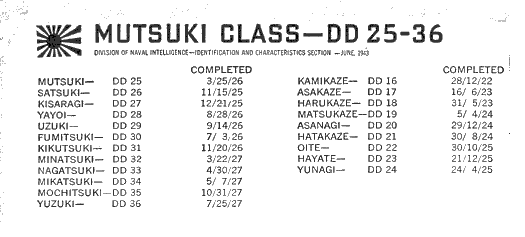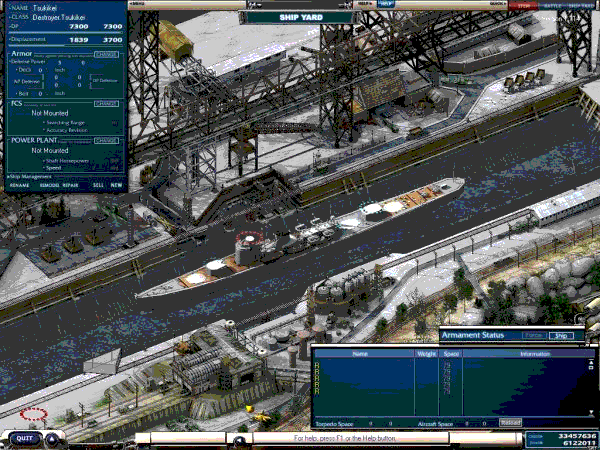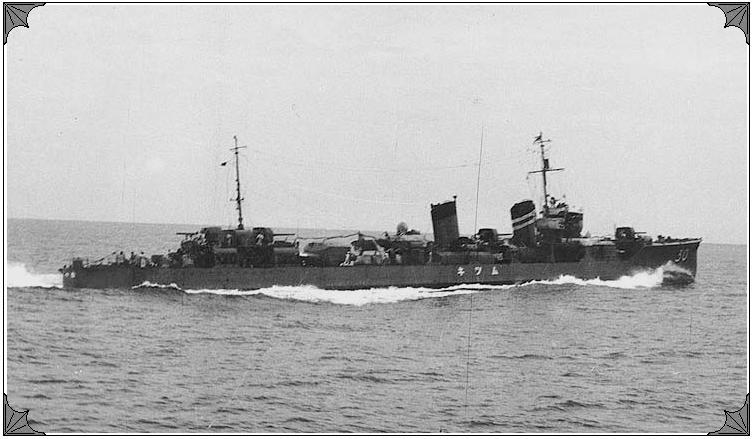
Imperial Japanese Navy - TSUKIKEI class Destroyer ==========================================================================
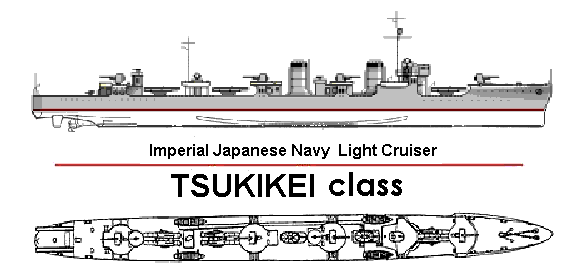
Mutsuki (--tsuki), was a 1315-ton first-class destroyer of the Imperial Japanese Navy, and the name ship of a class of twelve destroyers.
The Mutsuki class destroyers were a class of destroyers of the Imperial Japanese Navy. They were completed from 1924 to 1927. They were planned as Kamikaze class destroyers for the Eight-eight fleet project, however, they were planned after the Washington Naval Treaty to boost destructive power of the torpedo fleet, because construction of new battleships became impossible under the limitations imposed by the treaty.
The Mutsukis were completed in 1925-1927, primarily in naval yards. They were a disappointment to the Japanese, falling short of their design speed and proving flimsy in combat. No ship of this class ever survived a solid hit by a bomb or torpedo. As a result, most were converted to fast transports early in the war.
In 1941, they were already considered old, but became war potential as being the next best destroyer to the Fubuki class because they were equipped with 610 mm torpedoes. However, none of them survived the Pacific War.

The Kamikaze class destroyers were a class of destroyers in the service of the Imperial Japanese Navy from World War I through World War II.
Nine ships of the class were built, from 1921 to 1925. They were planned to reinforce the Minekaze class. In design, they were essentially improved Minekaze-class destroyers. By the time World War II broke out, the Kamikazes, largely obsolescent, were being modernized. Construction of the last two planned Kamikazes was cancelled in conformance with the Washington Naval Treaty. Oite, Hayate, Asanagi and Yunagi were called the Kamikaze class late production model (or Oite class), because the powerplant and armaments were different.
=========================
The Momi class destroyers were considered second class versions of the Minekaze design. The Momi class destroyers were entirely of Japanese design, but borrowed heavily from the concepts of the German based Minekaze destroyers. Laid down at the same time as the Minekaze class, the Momi were designated as second class destroyers. The ships initially had listing problems during high speed turns, which later was corrected by widening the beam and bring up the waterline. The Momi destroyers operated well in groups of two to four and were recognized as the main attack force used by the Imperial Navy of the time period.
=========================
The Minekaze, Kamikaze and Mutsuki class destroyers were essentially a single design with each group representing progressive development. As a group, they are visually interesting and are historically important as a pivotal design between early foreign built ships and the later original and highly innovative Kagero / Fubuki "Special Type" destroyers and their successors which played such a dominant role in the early surface battles of the Pacific War.
Prior to the First World War the Imperial Japanese Navy was very dependent on foreign suppliers for its arms and equipment. Many of the prominent overseas warship builders supplied vessels to the Imperial Navy with the majority being built in British yards. In addition, the Japanese Navy acquired many ships as prizes in both the war with China and the Russo-Japanese War. This combination allowed a very rapid expansion of the fleet while also affording ample opportunities to study foreign construction methods and techniques. Destroyers were purchased mainly from Yarrows and Thonnycroft, leaders in destroyer design at the time. Later, some units were built in Japan through licensing agreements.
As Japanese shipbuilding capacity expanded and the ship constructors gained more experience, original designs were built. Initially these were still based on British practice. The break from British design dominance occurred in 1916 when the Navy issued specifications for new First and Second Class destroyers. These new vessels, the Minekaze and Momi classes, departed from the traditional British layout, adopting a design that owed much to German ideas.
When compared with previous designs, the Minekaze class forecastle was lengthened with a break forward of the bridge forming a well deck where the forward torpedo mounts were placed. This well deck layout followed typical German torpedo boat design practice. A traditional turtledeck style forecastle was retained but the bow was flared more for better seakeeping qualities. The four 4.7"/45 cal. S.P. guns were evenly spaced along the hull length and mounted as high as possible so they could be worked in heavy seas. All the main armament, guns and torpedoes, were mounted on the centerline so that all could bear on either broadside. Six 21" torpedo tubes in three twin mountings were provided. Parsons geared turbines were fitted which delivered 38,000 shaft horsepower for a speed of 39 knots on trials. The Momi type, Second Class destroyers, were identical in appearance and design, except in scaled down form. They were smaller in dimensions and mounted only three 4.7" guns and 4 torpedo tubes in two twin mounts. While not all of these new ideas were completely successful, (the forward gun and torpedo mounting were swept by water in heavy seas and were sometimes unworkable), generally the new destroyers were fast and powerful ships that were equal to any of their foreign contemporaries.
The Minekaze and Sawakaze were ordered under the 1917 construction program and were followed by the Hakaze, Nadikaze, Okikaze, Shimakaze , and Yakaze under the 1918 program. None had been laid down when the war ended but it was decided to proceed with construction as many of the operational units were old and in need of replacement. Five additional ships, Akikaze, Hokaze, Slijokaze, Tachikaze, and Yukaze were ordered in 1919.
The last three ships of the class, Namikaze, Nokaze, and Numakaze, were ordered in 1920, built to an improved design with a better gunnery fire control system and improved ammunition magazine arrangements. Essentially these last three vessels, in their external revision, set the pattern for the following Kamikaze class. Gun and torpedo positions were changed, the gun mounted aft of the second funnel was moved further aft to X position. Torpedo mounts 2 and 3 were moved closer together and the searchlight platform formerly between them was moved forward to just aft of the second funnel. The following Kamikaze class ships were visually identical apart from slight detail changes in the bridge and the addition of an improved 4.7"/50 cal. main gun which was designed as a dual purpose mount.
There were nine units in the Kamikaze class. The first five ships were ordered under the 1920 program and assigned names, Okazc, Makaze, Tsumikaze, Soyakaze, and Suyukaze. The orders were carried over into the 1921-22 construction program but upon reordering only hull numbers were assigned in odd numbers from 1 to 17.
The parallel designs, Second Class destroyers of the Momi and Wakataka classes, were also ordered in this period and for a time after their completion were also not given the names assigned to them but were only known by their hull numbers. In 1928, all ships under this designation system received their names. In the case of the Kamikaze class, new names were assigned. In numerical order, these were; Kamikaze, Asakaze, Hanikaze, Matsukaze, Hatakaze, Olte, Hayate, Asanagi, and Yunagi.
Twelve units of the final type, the Mutsuki class, were ordered in 1923 and differed from the previous two groups in several ways. The Mutsukis were the first ships to be fitted with the newly developed 24' torpedoes which were arranged in two triple mountings. The hull form was improved with a swan neck bow design developed as a result of model testing in an experimental tank. The new bow shape became standard for all subsequent Japanese destroyer designs. In spite of an increase in tonnage and added fuel capacity the performance remained the same with no changes in the propulsion machinery. As with the Kamikaze class, the Mutsuki class originally were assigned hull numbers and only received their names in 1928. The hull numbers and names were; (19) Mutsuki, (21) Kisaragi, (23) Yayoi, (25) Uzuki, (27) Satsuki, (28) Minatsuki, (29) Fumisuki, (30) Nagatsuki, (31) Kikusuki, (32) Mikatsuki, (33) Mochitsuki, and (34) Yuzuki.
The Minekaze, Kamikaze and Mutsuki class ships formed the backbone of Japanese destroyer formations throughout the twenties and thirties until they were supplemented and later replaced by the "Special Types". As the Fubuki class and their improved successors became available in numbers the Minekaze and Kamikaze ships were withdrawn from first line service and reassigned to secondary duties. The Mutsukis were retained as first line destroyers due to their increased range and their more powerful torpedo armament.
The three groups retained their original appearance, relatively unchanged until the late thirties. Minor changes were made such as adding windows to the originally open bridge of the Minekazes. l3mm machine guns were replaced by 25mm guns, speaking tubes were added to the torpedo stations, (later being removed and replaced with a telephone system). At various times paravanes were fitted, the ships were classified as minesweepers as well as destroyers Funnels were fitted with higher caps thus visually increasing their raked appearance.
In September of 1935 units of the Combined Fleet while on exercises passed through a typhoon. It was a very violent storm with winds to 85 miles per hour and wave heights of over 50 feet. Many units of the fleet received severe damage including the Mutsuki which had several plates buckled and the top of her bridge wrecked. During 1936-37 Mutsuki and her sisters were fitted with a strengthened, more compact, semienclosed bridge structure. The side plating below the bridge was cut away and the forward boat davits were changed from radials to the swingout, goose neck type and relocated one deck lower. At the same time new watertight shields were fitted to the torpedo mounts similar to those on the "Special Type" destroyers then in service.
The Mutsukis, with their 24" torpedo mounts were able to accept the newly designed 24" oxygen driven "Long Lance" torpedo, a superb weapon with no equal in allied arsenals. With the new protected weather proof shields the torpedoes could be worked in all seas and weather conditions thus extending the useful life of the class in the fleet destroyer role. No such refit was contemplated for the Minekaze and Kamikaze classes as they were considered to be obsolete.
By 1938 most of the Minekaze class ships had been withdrawn and replaced by more modern ships in the fleet escort role. These still useful hulls were then converted to a variety of secondary roles such as patrol boats, escorts, and high speed transports. The Kamikaze and Mutsuki classes were also undergoing refits beginning in 1940-41. A common trend was the suppression of one or more of the 4.7 mounts and the addition of more anti-aircraft guns. This took the form of 25mm machine guns in single, double or triple mountings. This weapon was based on a French Hotchkiss prototype and was a rather elderly design by this time.
On paper, the additional anti-aircraft guns look impressive in their numbers but due to the fact that no central fire control system was developed to direct their fire the adding of more barrels firing independently had little effect on the ship's defensive capability. There was also a large gap in coverage between the 4.7 dual purpose gun and the 25mm gun that was never resolved. Japan possessed examples of the 40mm Bofors gun which would have been a possible solution to the problem but they were never produced in quantity. This serious deficiency in anti-aircraft defensive capability became more critical as the war progressed.
From early 1942 onward the Mutsukis were gradually withdrawn from fleet service. Some were converted to the escort role with reduced boilers and added fuel capacity for longer range. Contrary to some published sources not all of the ships were modified in this way which is apparent from studying wreck photographs. The amount of evidence available is not adequate to document all of the individual ships but there is ample to cover several in detail which can be considered representative of the appearance changes in the class.
The Minekaze, Kamikaze and Mutsuki classes parallel the USN 4-pipers in that all were available for secondary uses in large numbers and were utilized in very similar roles. It is interesting to compare the conversions done by both navies for the same mission. The degree of standardization apparent in some of the American conversions is not present in the IJN adaptations. Many of the IJN conversions are very individual, almost experimental in nature.
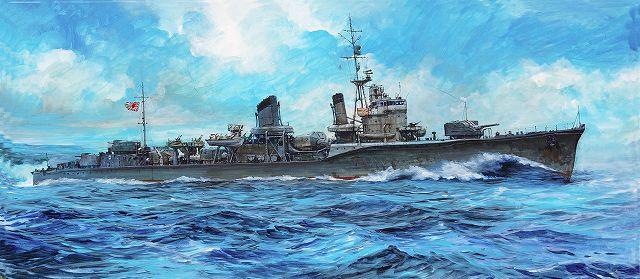
In World War II, the Imperial Japanese Navy (IJN) had at its disposal destroyers that included some of the most formidable warships of their type. This, with the power of the "Long Lance" torpedoes, came as a nasty surprise to the allies. These were the result of a radical redesign in the mid-1920s and an emphasis on technology and night fighting expertise. Development from one class to the next was not, however, a smooth progress. Aside from the usual refinements that stem from operating experience, serious design faults came to light and naval treaties imposed restrictions on unit and total displacement tonnage. As a result, the early "Special Type" destroyers required significant changes and the performance and armament of subsequent classes was reduced. Naval treaties were later abrogated in 1937 and destroyer development continued without regard to limits.
Generally speaking, the IJN requirements gave rise to warships that were substantially larger than their European equivalents. In the early war years, their advantages were aggressively exploited against the, often second rate and poorly coordinated (as at the disastrous Battle of the Java Sea), allied ships stationed in the region. The Japanese did not, however, install technology to match their opponents, and thus, destroyer numbers were eroded steadily. In recognition that quantity was as important as quality in some roles, design policy was, therefore, modified to produce units that were easier to build and operate. Despite this, Japan's destroyer force was halved by the end of the war.
The oldest Japanese destroyers at the declaration of war with the United States dated from World War I designs and were rated as "class 1" (greater than 1,000 tons (standard)) or "class 2" (under 1,000 tons (standard)). These had become, however, outclassed and unsuitable for front line duties and they had been relegated to coastal protection and escort duties, including support of the landings in the Dutch East Indies (now Indonesia), Philippines and Wake Island.
The Washington Naval Treaty of 1922 assigned Japan a tonnage allocation with which it was dissatisfied. IJN planners assessed their needs to protect Japan's maritime lifelines with the assumption that their most likely opponent would be the United States. A total of 144 destroyers was deemed to be necessary. In order to achieve a long ranged fleet that was capable of operating far from home waters and bases, treaty limitations were disregarded. The resultant design was the Fubuki class destroyer which were commissioned during 1928 - 1932. The Fubuki design became the basis for subsequent destroyer development but they needed significant modification when stability and hull strength problems became apparant. These modifications were worked into new ship designs.
The London Naval Treaty of 1930 added more restrictions to ship design and displacements were temporarily reduced (Hatsuhara and Shiratsuyu classes) until Japan withdrew from the naval treaties. The subsequent Asashios, Kageros and Yugumos resumed the design evolution and delivered the ships that the IJN desired, with substantially increased displacements. Further technical developments were prototyped in the Shimakaze, but the design was not continued. Although the anti-aircraft (AA) defences of Japanese destroyers were shown to be inadequate, the IJN had recognised the need for fleet AA defence and the Akizukis were intended to fill this need.
Japanese destroyers performed the usual range of tasks, fleet and convoy escorts. supply and reinforcement runs to various isolated island outposts and garrisons. Japanese destroyers were particularly skilled at night actions and the use of torpedo salvoes, tactics which attracted success in several actions. This advantage, however, was reduced by the allies' use of superior radar and resources.
A substantial number of Japanese destroyers were lost in 1942 in actions around the Solomon Islands. The urgent need for replacements necessitated design simplifications to improve construction speed and war experience prompted improvements to damage control and anti aircraft weaponry. The resultant Matsu class destroyers were commissioned in 1944.
The Matsu class destroyers were a class of destroyer referred to as Type-D Destroyers.
The Kagerô class destroyers and the Yûgumo class destroyers were called Type-A Destroyers.
The Akizuki class destroyers were known as Type-B Destroyers.
The Shimakaze class was a Type-C Destroyer.
The Matsu class were built late in World War II, and they were intended to be more cost-effective in response to the changing character of naval warfare at that time. These ships were lighter and smaller than previous Japanese destroyers (TSUKIKEI = zuki kei = "little moon" = small destroyers ?), with different armament such as enhanced anti-aircraft guns and anti-submarine weapons, and radar. Since surface warfare was believed to be less likely at this stage of the war, armament such as torpedo tubes that would be useful against surface ships was reduced.
As in other navies during the war, the IJN substantially simplified the design to speed up construction, and used Ôtori class machinery, because high speed was unnecessary for convoy escort operations. However, mass production was not achieved.
The Matsu class escort destroyers were designed as a replacement of naval losses with a shortage of raw materials in mind. They had a simplified design and were made for swift construction. The Matsu were the first Japanese ships designed with an improved layout for boilers and turbines to decrease the chances of total power failure should a bomb successfully target the engine compartment.
Despite having a displacement half of previous destroyers, the Matsu were still heavily armed with anti-aircraft weaponry and quadruple torpedo tubes. The destroyers were ordered in the 1942 Program and were laid over the next two years. Eighteen destroyers in total were built, while an additional eleven were cancelled. Eleven survived the war with many being handed over to the victorious Allied powers.
The Matsu, first of her class, completed and launched in late April, 1944. Commissioned, she was assigned to the 11th Submarine Flotilla, and later the Fleet Escort Force. She successfully participated in the Third "I-Go" operation, which involved transporting reinforcements to Iwo Jima and Chichi Jima islands. It was on the return of this mission that the Matsu met her fate, when the American Task Force 38 hunted down the Japanese fleet. In order to save the fleet, the Matsu remained behind and confronted a U.S. cruiser fleet composed of fifteen ships. She was sunk on 4 August 1944.
The Matsu class design was subsequently further simplified, to theTachibana class destroyer or Modified Type-D Destroyer. The Tachibana class destroyers were the first to adopt modular designs in a Japanese destroyer. Matsu class destroyers whose construction was started late in the programme were completed as Tachibana class.
=================================================================================
NB: The above text has been collected / excerpted / edited / mangled / tangled / re-compiled / etc ... from the following online sources :
IJN - MUTSUKI class Destroyer - wikipedia article #1
IJN - MUTSUKI class Destroyer - wikipedia article #2
IJN - KAMIKAZEI class Destroyer - wikipedia article #3
IJN - TSUKIKEI class Destroyers - wikipedia article #4
IJN - MATSU class Destroyer - wikipedia article #5
IJN - MATSU class Destroyer - www.globalsecurity.org
IJN - TSUKIKEI class Destroyers - smmlonline.com
Destroyers of the Imperial Japanese Navy - wikipedia list of pages

